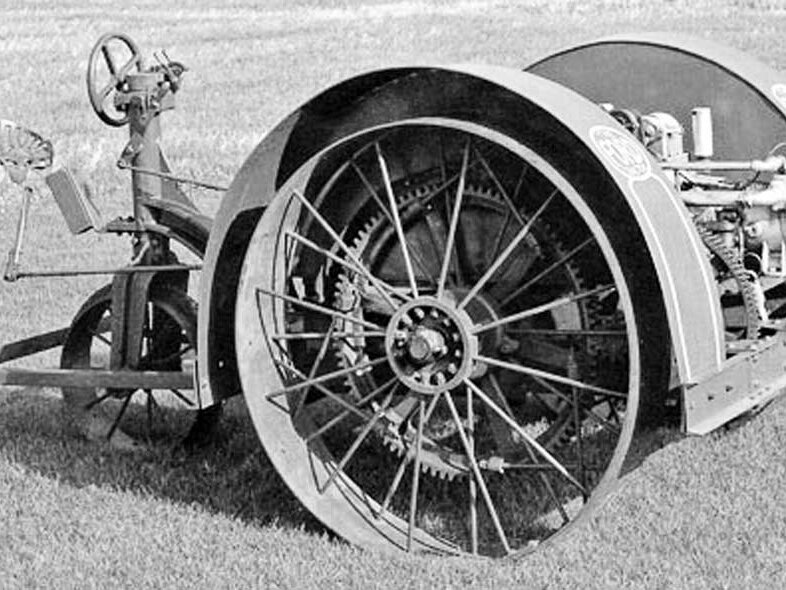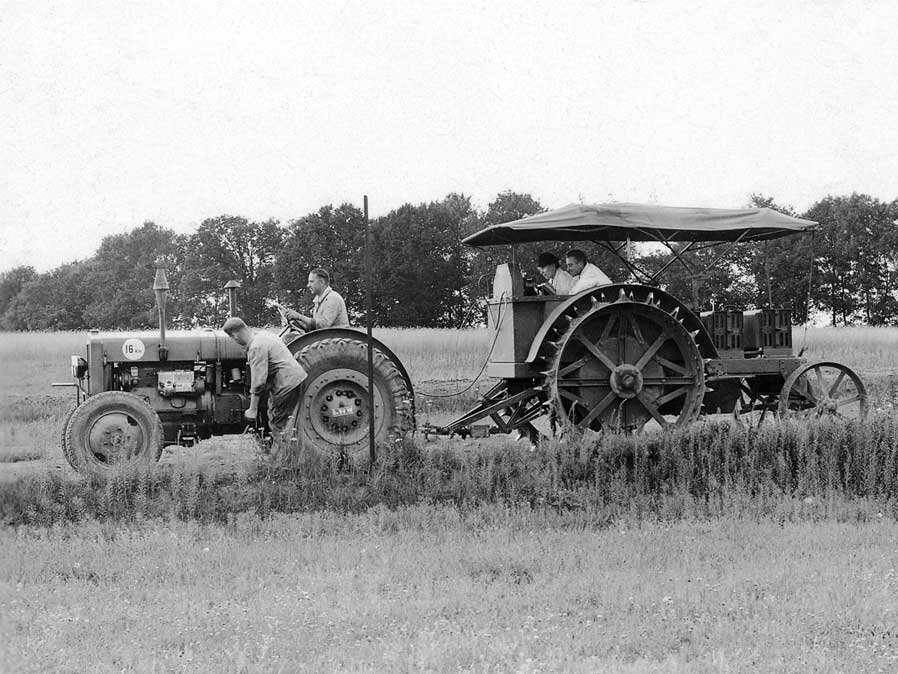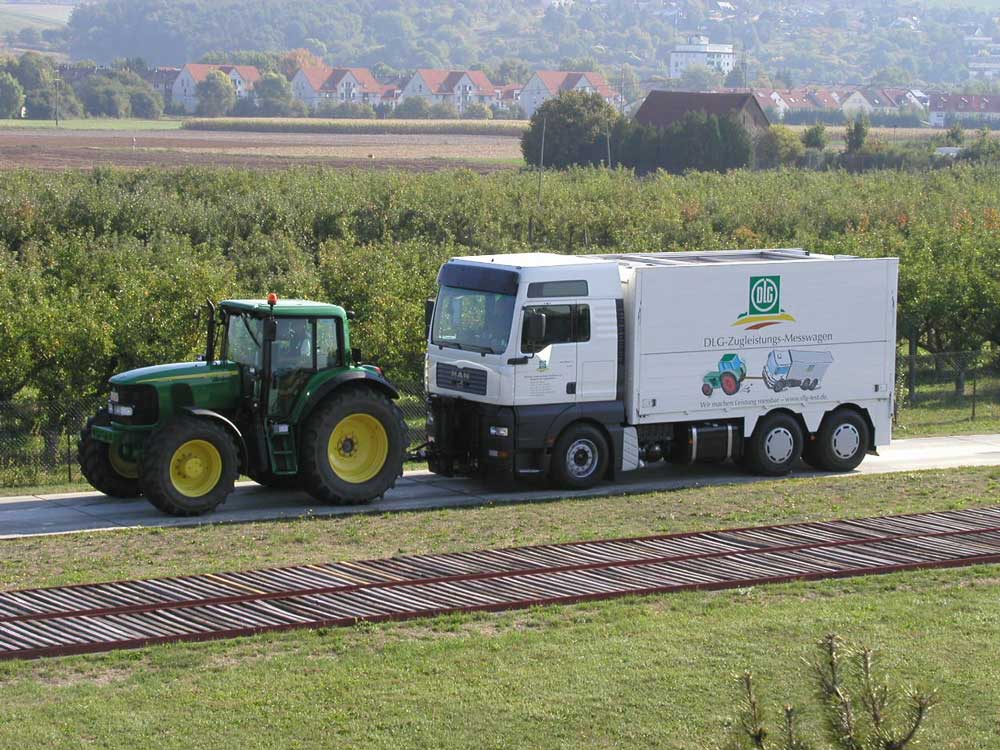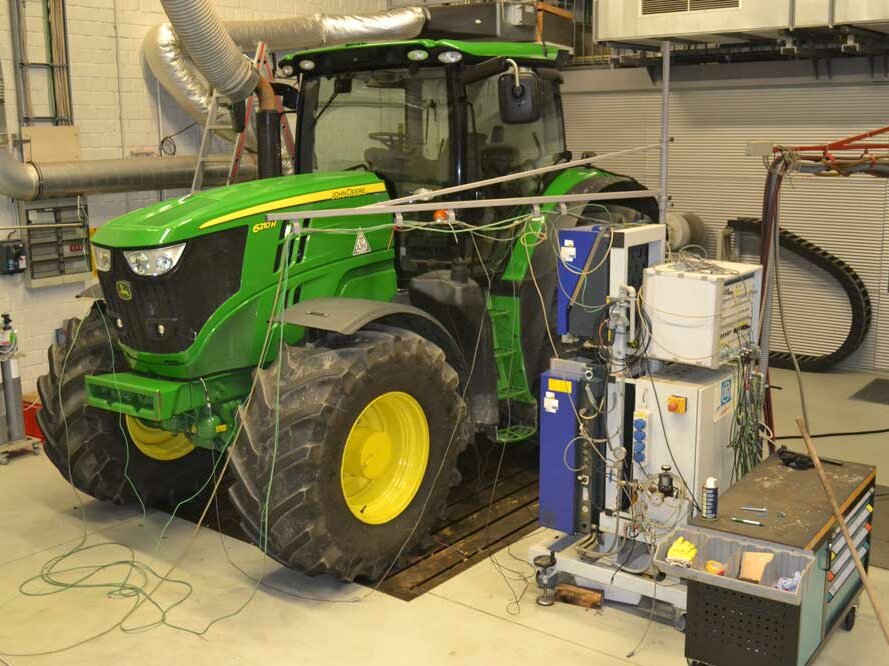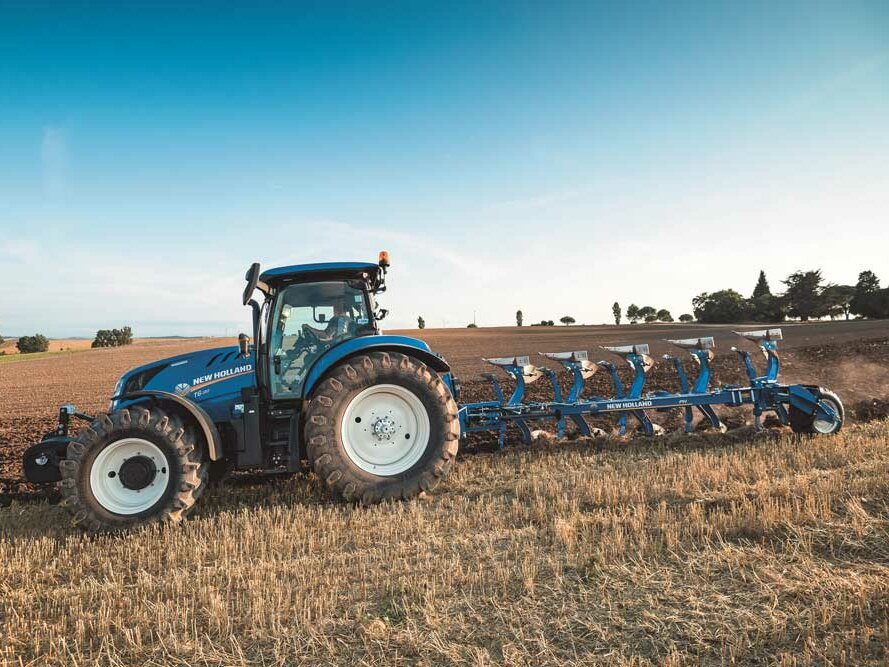The development of tractor testing: DLG PowerMix
By Frank Volz, DLG Test Center Technology and Farm Inputs
Tractor tests have a very long tradition. Their source lies in the Nebraska Tractor Test Act of 1919, a law passed in the US state of that name. Its introduction can be traced back to the bad experiences of a farmer with his first tractor. This was a Ford Model B, bought in 1916 from the Ford Motor Company in Minneapolis, a company which had nothing but the name in common with the famous car make. The model was sold to the farmer in question as an 8 – 16 HP tractor with ability to pull a two-furrow plough. But this tractor failed to meet those claims. In fact, reliability wasn’t its strength either, the tractor breaking down before the dealer’s invoice arrived. Even after it was exchanged for a 1917 model, and then a “Little Bull” tractor, performance did not satisfy. Not until the fourth tractor in three years, this time a Rumily OilPull, arrived on his farm, was Wilmot Crozier satisfied. This man was subsequently elected as senator in the Nebraska legislative in 1919 and pushed through the above mention statute stipulating that no tractor was, or is until this very day, allowed to be sold in Nebraska without a “permission”. This permission is given to a manufacturer or dealer only where a tractor meets all advertising claims made for it, and after a test undergone in the presence of three engineers. Another stipulation in the act: a workshop must be on-hand with a good supply of spare parts for the tractor in question.
Tests from 1920
Following the first successful test on a John Deere Waterloo Boy Model N on 31st March, 1920 there was continual progress: 65 successful tests in the first year, a total 172 tests up to 1930 – all in the Nebraska Tractor Test Laboratory (NTTL), situated in the Department of Agricultural Engineering at Nebraska University. By the end of the 1950s/beginning of the 60s, the Nebraska Tractor Test Act was relaxed a little, from then on applying only to agricultural tractors over 20 HP.
As early as 1929, German engineers followed the above example on the tractor testing field at Potsdam-Bornim where the first German draught performance measurement wagon started tests. Manufacturer was the Institut für Landmaschinenkunde der Landwirtschaftlichen Hochschule Berlin (Institute for Agricultural Engineering, Agricultural University of Berlin). As is easily recognised through the steel wheels with spuds, testing in those days was only on unpaved surfaces. However, even then – as in the USA too – fuel consumption was already being recorded during field tests. While agricultural machinery testing was being continued in the GDR in Bornim, the tractor tests moved via the KTL test fields at Schloss Rauischholzhausen near Marburg and Darmstadt-Kranichstein, to finally land 50 years ago in the then newly opened DLG testing facility for agricultural machinery at Groß-Umstadt, now the DLG Test Center Technology and Farm Inputs. Here, the lines of history come together: within the framework of the Organisation for Economic Co-operation and Development (OECD), the NTTL was announced in 1986 as official US American, and the DLG Test Center Groß-Umstadt as official German, OECD test station. The tests according to OECD Code 2 comprise a state-of-the-art testing programme for determining power output capabilities of agricultural and forestry tractors. Key information as well as a search possibility of the respective summaries is available under www.oecd.org/tad/tractor.
The DLG PowerMix
As with many test procedures, the OECD Code 2 tests were continually under criticism. Above all, complaints came – and still come - from farmers that the results were produced through stationary measurements of pto power, lifting capacity and hydraulic performance, and for draught power through the brake truck, and that the associated engine operating point for the individual measurements is precisely stipulated. In principle, the criticism is similar to that of the legally required driving cycles for private cars on engine test stands and rolling test beds for determining emissions and therefore taxation. There, manufacturers have considerable freedom as to disconnection of ancillary power consumers such as dynamo and air conditioning, minimising vehicle weights, adapting the engine management or high air pressure in tyres to reduce rolling resistance. In short: the affinity to practical conditions was missing.
On these grounds, the vehicle technology engineers established in 2005 a new generation of tractor testing at the DLG Test Center with the DLG PowerMix. Today this represents the “Platinum Standard” of international tractor tests. As with the real work in the farmyard and on fields, firstly the DLG Brake Truck was used. And then since 2015, the DLG PowerMix rolling test bed for assessing drawbar draught, pto and hydraulic performances combined and under the required emissions control.
The 14 load cycles in the DLG PowerMix
The base figures for the setpoint characteristics of the nowadays total of 14 work cycles (see table) are delivered by performances in the field with commercially available mounted implements.
To compare fuel consumption figures for tractors of different power classes, these are first given as specific fuel consumption i.e. in grams per kilowatt hour (g/kWh). Modern engines nowadays achieve thereby - despite extensive exhaust gas cleaning – consumptions markedly under 300 g/kWh. On the DLG rolling test bed nowadays, specific fuel and AdBlue consumption from tractors of up to 700 kW (1000 HP) can be measured. During the measurements the tractor stands on four 2 m diameter steel rollers driven by electric motors and which can be braked. These are adjustable to fit the required inter-axle space measurements from 2.05 m to 6.00 m. In total, each unit comprising rollers, electric motor and engine frame, tips the scales at around 35 t – stable enough to cope with maximum axle loads of 30 t, i.e. a maximum 60 t real tractor weight. The maximum transferrable draught power per wheel represents hereby 135 kN or 13.8 t. New is also an air conditioning system which, ensures a stable room temperature of 25°C in the testing hall through exchanging 100,000 m3 of air per hour. Since the change in testing procedure to the new rolling test bed, testing possibilities with the DLG PowerMix have been further improved. Thus now available for farmers are practically relevant consumption and performance figures for all important tractor types.
Falsified results? Impossible!
With the background of it no longer being a problem nowadays with modern tractors to increase engine power or reduce fuel consumption through manipulating the engine management software, the DLG Test Center Technology and Farm Inputs is repeatedly asked by farmers whether the tested machines are in fact series models. After all, the DLG tests are voluntary and the machines tested are supplied by the respective manufacturers. The DLG confronts possible tuning accusations on two levels. Firstly, under the rules for participating in a DLG PowerMix test, the manufacturer must confirm under liability that the tractor in question is a series model and give its registration details. Secondly, every tractor to be tested undergoes a preliminary power test at the pto following arrival at the DLG Test Center.
In the first place, this serves to establish load levels for the measurements in the following DLG PowerMix test, i.e. for the different cycles the theoretical working widths of mounted implements are steplessly adjusted until the specified load point, e.g. 40%, 70% or 100% of the maximum engine performance is reached. Within the framework of this recording DLG test engineers also record the full load curve of the machine and the associated inputs, as well as the nitrogen oxide emissions. These are compared with the official registration details. Especially the exhaust gas follow-up inspections carried out according to guideline 97/68/E, would make obvious an excessive optimisation of fuel saving. In a checking of the measurement method by the DLG – with which, incidentally, all leading international test stations work - it could be proved that in the case of fuel savings of about 10%, a simultaneous rise in nitrogen oxide (NOx) of up to 80% is to be seen. In fact, in certain engine operating points the NOx readings even rise by over 200%. These results clearly show that even a small reduction in fuel consumption leads to a marked rise in the nitrogen oxides produced. Remeasurement of similar-specification tractors already regularly tested, being machines offered to the DLG by farmers without the knowledge of the manufacturers concerned, indicated variations within the framework of series scatter.
No. | Load type | Loading of tractor | Practical work equivalent |
1 | Draught | 100 % | Heavy ploughing |
2 | Draught | 60 % | Medium ploughing (light soil, under dimensioned plough) |
3 | Draught | 100 % | Deep grubbing |
4 | Draught | 60 % | Medium grubbing (e.g. stubble cultivations) |
5 | Draught and pto | 100 % | Heavy work with power harrows (e.g. deep cultivations) |
6 | Draught and pto | 70 % | Medium work with power harrows |
7 | Draught and pto | 40 % | Light work with power harrows (e.g. shallow work, light soil) |
8 | Draught and pto | 100 % | Heavy mowing (e.g. first cut, or with conditioner) |
9 | Draught and pto | 70 % | Medium pto work (e.g. 2nd cut or lower yield) |
10 | Draught and pto | 40 % | Light mowing (e.g. front mower work) |
11 | Draught, pto and hydraulics | 100 % | Dung spreading |
12 | Draught, pto and hydraulics | 60 % | Baling |
13 | Transport | 100 % | Heavy transport work (e.g. mountain roads) |
14 | Transport | 25 % | Light transport work (e.g. on the flat) |
Presentation of results in new numerical values
With the actual testing of a New Holland T6.180 Dynamic Command, the DLG Test Center supplemented the results from the DLG PowerMix with further numerical values. Instead of, as previously, giving diesel consumption in only specific terms, i.e. in grams per work hour (g/kWh), further practically oriented values were now given. Thus there resulted from the DLG PowerMix mean value of the previously scaled field cycle working widths and the mean driven speed the area performance in hectares per hour or, from the virtual loading of the trailer and the resultant actual weight of tractor and trailer together, the transport performance in tonnekilometres per hour. From these values one can then calculate back to find consumption per hectare or tonnekilometre. With such figures, the farmer finds a new presentation of results from the DLG PowerMix with additional practically relevant numerical values available.
New Holland T6.180 Dynamic Command
The latest model in the T6 series: the T6.180 Dynamic Command, rounds up the model line and complements the only 6-cylinder tractor of the series with the 8-step semi-powershift Dynamic Command transmission with dual clutch. With that, now - with the exception of the T6.125 – all models in the line are available with three transmission options: Electro Command, Dynamic Command and Auto Command. The tractor is powered by a NEF 6.7 l engine that fulfils the exhaust gas stage IV requirements with HI-eSCR without exhaust gas recirculation. In the Dynamic Command transmission, the four even and four uneven gears have their own respective shafts and clutches. When changing gear, one clutch opens while the other simultaneously closes, meaning smooth and efficient gear changes. Changing between the three groups is automatic.
PowerMix results
129 kW/175 PS measured according to UNECE R 120 standard is claimed by New Holland as maximum power for the tractor in “boost” mode. For this standard the power is measured by flywheel dynamometer. Radiator, cooling fan and other ancillary equipment, i.e. air conditioning or hydraulic pump are, as shown above, not driven during the test. This brings an extra 120 kW/163 HP at the pto stump, according to the OECD Code 2 measurements, i.e. those recorded including the ancillary components. In the energy efficiency values, the T6.180 DC achieved 267 g/kWh diesel and 25 g/kWh AdBlue over all field cycles, in transport 464 g/kWh diesel, 33 g/kWh AdBlue. These values are based on, once again with figures recorded over all field cycles, an area performance of 5.7 ha per hour and transport performance of 690 tonnekilometres per hour. Based on the hectare or tonnekilometre, the T6.180 Dynamic Command needed 6.0 l/ha diesel and 0.4 l/ha AdBlue in the field and 4.3 l/100km/t diesel and 0.3 l/100km*t AdBlue during transport.



